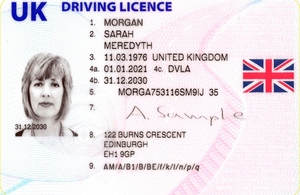
UK Van Driving Licence full Guide – Drive Vans Legally
Moving homes and looking at small vans that you can hire to transport your boxes from your old address to the new one? Considering building a fleet of 3.5-tonne Luton vans and becoming the business owner of the next best man and van company in town? Many van drivers find that a full UK driving licence is adequate for most vans they plan to use, particularly in urban environments where smaller, mid-sized vans are more practical. In any of these situations, you might have already asked yourself the vital question – What license do I need to drive a van?

When getting behind the wheel of one of those new electric vans, or even one of those good old Lorries of up to 3.5 tonnes – you’d want to make sure you have the proper certification for the job. A standard driving licence is often sufficient for driving a van, but it’s important to be aware of the gross vehicle weight (GVW) restrictions. On one hand, having a suitable full UK driver’s license guarantees you are qualified to operate such a machine. On the other hand, being legally able to drive a van will save you a lot of hassle should the police stop you for a check.
While a car licence allows you to drive vehicles of a certain size, for larger vans, a different type of licence might be required, especially when the combined weight of the van and any towed trailer exceeds a certain limit.
Can you drive a van on a car license?
Holders of a valid UK driver’s license are qualified and allowed to drive vans of up to 3.5 tonnes. However, if you’re driving commercially, you may need a category B licence, which ensures that you can drive a van safely and effectively. No matter whether you are a one-man operation, a business owner, or someone who wants to move a few boxes or pieces of furniture without engaging a full-scale professional moving service, this is good news. The full UK driver’s category B license entitles you to drive small vans, medium vans, and large vans, along with cargo or up to eight passenger seats. It’s crucial for licence holders to understand the permissible maximum weight of the van to ensure compliance with legal requirements. It is important to remember that you should be very mindful of the maximum weight limit of 3.5 tonnes, which should not be exceeded unless you hold another, professional-level driver’s license.
What license do I need to drive a van?
It is considered that if you’ve managed to pass the general car driving test and joined the ranks of category B license holders, you are qualified to operate such a van as well. This means that with a standard car driving licence, most everyday van driving needs are covered, although for special cases, additional endorsements might be required.
Category C License
In case you are willing to operate heavier vehicles – between 3500 kg and 7500 kg, or a van and trailer combination, you are going to need a category C license. This category C licence is essential for those who wish to drive commercial vehicles of a larger scale, including vans weighing more than the typical limit for a full category B licence. Such license holders go through a much more rigorous training and testing process. Additionally, category C licence holders must be aware of daily driving limits and regulations specific to heavy goods vehicles. They are also required to go through a thorough medical assessment to renew their license, which differs considerably from what you would have to do for a regular license. This category also comes with a requirement for certain driving hours covered with both rigid axle vans, larger vehicles, and smaller vehicles. For those holding a provisional licence, the journey to acquiring a full driving licence that includes category C can be extensive but crucial for a career as a van driver. You might even have to tow a trailer during the examination to prove you are capable of it and cover your license requirements. Once you pass your driving tests, you will join the ranks of HGV-licensed professionals and can use your skills for business purposes. The license should be renewed every 5 years until you are 65 if you’d like to keep holding it.
After the age of 65, you will need to renew your license – which includes taking all tests again – every year. That category is known as C1. You will need a C1E category if you’d like to drive a large vehicle of up to 7.5 tonnes with a trailer attached to it. In that case, the gross vehicle weight of the composition cannot exceed 12,000 kg.
Electric vans – a side note
It was in 2017 when a new regulation about electric vans was introduced by the English government. According to this amendment, you can now drive an electric van of up to 4250 kg with a regular car license – either category B or category B1. This change reflects the increasing popularity of alternatively fuelled vehicles, which are often heavier due to their batteries but are considered important for environmental sustainability.
Category B and Category B1 permit you to drive vans with a maximum authorized mass of up to 3.5 tonnes in all other cases.
How about minibuses?
There is a separate category of transport vehicles – mini-busses. They are similar to vans, but instead of cargo, you will be using them to transport people. Those are vehicles with 9 to 16 passenger seats. When driving a minibus, it’s essential to have the correct licence, especially if the vehicle falls within certain licence categories. In theory, you may be able to drive such a vehicle with a regular full category B license. You will, however, have to cover some other requirements as well. First at foremost, you will need to be at least 21 years old to drive a minibus. Additionally, the full UK driving licence must be held for a sufficient period, usually at least two years, before you can legally operate a minibus. You will also have to be able to prove you’ve had your category B license for at least 2 years prior to starting on the minibus.
The vehicle itself should not weigh more than 3500 kg unless it falls into the category of alternatively fueled vehicles, or if it carries mobility equipment such as wheelchairs. In that case the maximum weight permitted increases to 4250 kg. One very important stipulation of the law when it comes to driving minibusses with a category B license is that you do not receive payment for driving the vehicle. Remember, category B isn’t a professional-grade category, after all. Your passengers should not be charged for riding in the minibus either, and the vehicle should be used for non-commercial purposes, at least until you are behind the wheel.
Further Provisions
Having the proper car license for the vehicle you are going to use for commercial purposes or everyday use is the first step to driving a van legally in the UK. Understanding the variety of licence categories and the specific requirements of each is crucial for every aspiring van driver. There are other things, such as the domestic rules of the county you are driving in, to take into consideration. Make sure that you know the speed limits in your areas, so that you can properly consider your route and driving plan. Additionally, van drivers must be familiar with the regulations regarding towing, especially if they plan to tow a trailer or operate vehicles with a significant gross vehicle weight. Remember that commercial vans need to be registered and inspected by the Vehicle Standard Agency. All vans in your fleet will receive a vehicle identification number that needs to be included in the paperwork you fill out regarding the commercial activities that you are going to carry out with the help of the vehicle in question.
Other skills such as estimating your fuel load will also definitely come in handy no matter whether you will be using the van professionally daily, or you are just planning a one-off long-distance trip to bring some furniture to friends, family, or your new place of residence. Remember, the better you know the van you are driving, the safer your trips with it are going to be. When you pass your test and get a driving license you have proven you’ve learned the basics. Now it is time to master the craft of driving a van.
More to know about driving Vans Legally
In the context of driving vans for personal or commercial use, it’s important for car licence holders, especially those intending to drive a van for business purposes, to understand the nuances of various licensing requirements. Category B licence holders, typically with a standard car licence, should be particularly mindful of the maximum authorised mass when choosing a van for transportation needs. For instance, a van weighing over the stipulated limit might require additional certification. Modern vans, like the popular Ford Transit, are favorites among hire company fleets due to their reliability and capacity. However, when taking a van abroad, drivers should be aware of international driving regulations, which may demand a higher level of professional competence. In such cases, a HGV licence could be necessary to meet the stringent requirements of cross-border transportation.
What are the most popular vans under 3.5 tonnes?
No matter whether you are looking into opening a van hire service, or you are just willing to pay for such, it might be a good idea to look into the most popular models of vans you will be permitted to drive with your category B license:
- Fiat Ducato – this cheap, reliable vehicle has received numerous awards over the years and is often seen on the roads in both the UK and Europe. There are good reasons for that – starting from the optimal cargo efficiency it offers to the over 40 years of traditions when it comes to customer support and satisfaction. Even though Ducato rarely breaks down, fixing it is cheap and easy as well – which is one more reason you will be seeing a lot of van hire fleets of namely these vehicles.
- Renault Master – the French rival of Fiat is a tough van that will live up to the expectations of any business owner. It is a smart-looking, modern vehicle built with old traditions in mind – meaning that it can fit a lot of cargo, and help you drive a van safely to the assigned destination no matter how challenging the road ahead seems to be.
- Citroen Relay – this van comes in as many as four length and three height variations, meaning that you can find one precisely fitted to the individual needs of your business. In recent years the Relay received several awards for driver’s and passengers’ safety, which is yet another reason to consider building your fleet of precisely these vehicles.
About author
-

-
Jeremy Oliver
Previously serving as a logistics coordinator, Jeremy's comprehensive understanding of the industry gives him the ability to translate complex procedures into easy-to-understand blog posts. He has a particular knack for tackling the intricacies of London's removals scene, from the congested roadways to the unique challenges of navigating historic neighborhoods. As an authentic Londoner, Jeremy combines practical knowledge with his inherent love for the city, offering readers not only information on man with van removals but also local insights and valuable tips.


